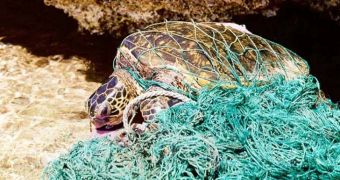According to a recent paper in the journal PLOS ONE, plastic bottles and bags, together with fishing nets and other types of human litter, can now be found at considerable depths in our planet's seas and oceans, and also further away from land than anyone would expect.
The problem with having litter become part and parcel of marine ecosystems is not that plastic bottles and coral reefs do not really mix and match color-wise. On the contrary, what worries specialists is the fact that aquatic creatures are likely to mistake trash for food and eat it.
Given the fact that plastic and other similar materials are not exactly what some would call stomach-friendly, this means that litter in our planet's seas and oceans constitutes a threat to marine biodiversity.
EurekAlert informs that, hoping to determine just how big a problem plastic bags and bottles are to aquatic ecosystems, an international team of researchers took the time to collect and analyze samples from across the Atlantic and Arctic Oceans, and the Mediterranean Sea.
All in all, the scientists who took part in this study collected some 600 samples from depths ranging from 35 meters (approximately 115 feet) to 4.5 kilometers (nearly 2.8 miles), the same source tells us.
It was thus discovered that litter can be found all throughout the Mediterranean Sea, and even towards the Mid-Atlantic Ridge, at a distance of about 2,000 kilometers (roughly 1,243 miles) from land. Interestingly enough, it appears that dense accumulations of litter are most common in deep underwater canyons.
“This survey has shown that human litter is present in all marine habitats, from beaches to the most remote and deepest parts of the oceans,” said Dr. Kerry Howell, Associate Professor at Plymouth University's Marine Institute.
“Most of the deep sea remains unexplored by humans and these are our first visits to many of these sites, but we were shocked to find that our rubbish has got there before us,” the researcher added.
By the looks of it, the researchers stumbled upon litter at each and every one of the sites that they surveyed as part of this investigation. They say that, according to evidence at hand, plastic bags and bottles are by far the most common types of human litter found on the ocean floor.
Still, discarded fishing lines and nets are a fairly common sight too, the scientists explain. Oddly enough, it turns out that glass and metal, clothing, and even pottery, together with some unidentified materials, can also be found on the ocean floor.
“The large quantity of litter reaching the deep ocean floor is a major issue worldwide. Our results highlight the extent of the problem and the need for action to prevent increasing accumulation of litter in marine environments,” Dr. Kerry Howell wished to stress.

 14 DAY TRIAL //
14 DAY TRIAL //